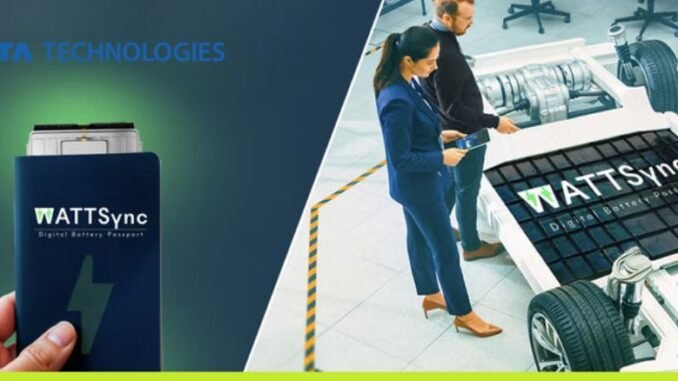
Tata Technologies has unveiled WattSync, a blockchain-enabled SaaS platform designed to deliver end-to-end traceability of EV batteries. Piloted with Agratas and Jaguar Land Rover, the tool enables global OEMs and battery manufacturers to comply with upcoming battery passport regulations across the EU, US, China, and India.
Addressing Global Battery Passport Regulations
The European Union’s new battery passport legislation, set to take effect in 2027, will require every EV battery to have a cradle-to-grave record. This includes:
- Mining and sourcing of raw materials like nickel, manganese, and cobalt
- Cell manufacturing and pack assembly details
- Data on recycling and safe disposal at end-of-life
Similar regulations are expected in California by 2026, China by 2028, and India around the same timeline. The US is also preparing to follow with stricter norms between 2028–29.
WattSync: Seamless Integration with OEMs’ Digital Systems
WattSync has been designed as a flexible cloud-based solution that integrates with an OEM’s back-end systems such as PLM, MES, and ERP. Leveraging blockchain, AI, and ML, it ensures secure and transparent traceability of battery lifecycle data.
Key highlights of WattSync include:
- SaaS-based solution with modular deployment
- Integration timeline of 2–4 weeks
- Flexible hosting by either Tata Technologies or the OEM
- AI/ML capabilities for prognostics and predictive analytics
Marc Manns, Vehicle Line Director – Electrical and Electronics at Tata Technologies, explained, “WattSync is a holistic traceability platform, ensuring battery cell manufacturing all the way to recycling. It is driven by legislation as well as companies’ sustainability goals.”
AI and ML for Predictive Insights
Unlike traditional battery passports, WattSync incorporates AI and ML to deliver predictive diagnostics. Jaguar Land Rover has piloted this feature to identify, pre-empt, and troubleshoot battery issues in real time—preventing failures such as thermal runaway and enhancing customer safety and satisfaction.
Benefits include:
- Early fault detection and prevention of safety incidents
- Increased brand reliability and customer trust
- Data monetisation opportunities while ensuring GDPR compliance
The platform uses GDPR-compliant datasets with 93 parameters considered under EU regulations, providing OEMs with actionable insights while adhering to strict data protection norms.
Built with a Global-Local Approach
Tata Technologies has developed WattSync with a distributed team across the UK, Sweden, India, and China. A significant share of the software engineering was undertaken in Pune and Bengaluru, highlighting India’s role as a development hub for advanced automotive technologies.
The company’s powertrain, vehicle connectivity, and cybersecurity teams have collaborated to make WattSync a future-proof, secure platform.
A Step Towards Supply Chain Resilience
Beyond compliance, WattSync also strengthens OEMs against supply chain disruptions. By offering real-time, data-first transparency across the battery lifecycle, the tool enables better decision-making for sourcing, logistics, and recycling strategies.
Adapting WattSync for the Indian Market
While EU regulations are highly detailed, Tata Technologies plans to tailor WattSync for India’s cost-sensitive market. The platform’s modular and flexible structure ensures it can be customised to suit local data sets and affordability considerations.
According to Manns, “The EU has a strong set of parameters, but in India, it will be important to define the exact data set to be procured from the battery. We have built WattSync with the right attributes and will make it more suitable for India’s requirements.”
Conclusion
With WattSync, Tata Technologies is pioneering a digital-first approach to EV battery traceability that meets global sustainability regulations while delivering additional value through AI-driven prognostics. As the EV industry faces rising compliance challenges and supply chain complexities, WattSync positions Tata Technologies as a key enabler in ensuring safety, transparency, and sustainability across the battery lifecycle.






